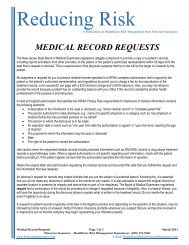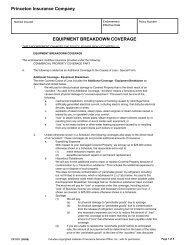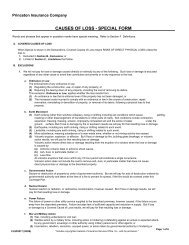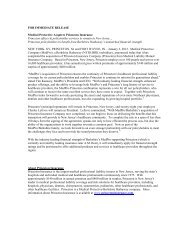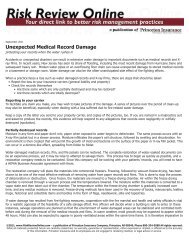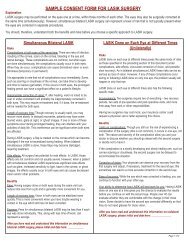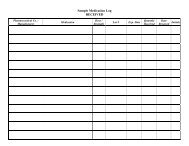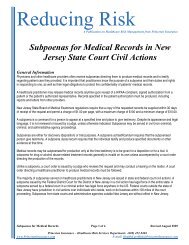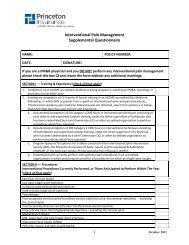Instructions for Completing a Physician Office Event/Complaint Report
Instructions for Completing a Physician Office Event/Complaint Report
Instructions for Completing a Physician Office Event/Complaint Report
You also want an ePaper? Increase the reach of your titles
YUMPU automatically turns print PDFs into web optimized ePapers that Google loves.
<strong>Instructions</strong> <strong>for</strong> <strong>Completing</strong> a <strong>Physician</strong> <strong>Office</strong> <strong>Event</strong>/<strong>Complaint</strong><br />
<strong>Report</strong><br />
INTRODUCTION<br />
These instructions are provided to assist in the reporting of events. These definitions are intended <strong>for</strong> the<br />
physician office practice to use as suggestions in order to maintain consistency in the reporting and tracking<br />
of events.<br />
Purpose of the <strong>Event</strong> <strong>Report</strong><br />
The purpose of an event report is to notify the responsible individual within the physician office practice of<br />
all events with actual or potential injury to patients and visitors. The event report <strong>for</strong>m also serves to<br />
document the event and provide a method to track and trend events over time so that improvements can be<br />
made.<br />
What is an event<br />
An event is comprised of any happening that is not consistent with the routine or usual operation of the<br />
practice, i.e., any deviation from policy and procedure. Injury does NOT have to occur. A “near miss” or<br />
the potential <strong>for</strong> injury and/or property damage is sufficient <strong>for</strong> an event report to be completed.<br />
When to do an event report<br />
An event report should be completed immediately following any unusual occurrence, once the persons<br />
involved have received the necessary treatment or attention if indicated. The report should also be<br />
completed <strong>for</strong> any deviation from the practice’s own policies and procedures. ONLY factual, objective<br />
in<strong>for</strong>mation should be contained in the report. Documentation of blame or finger pointing is inappropriate.<br />
Who should complete<br />
Completion of the report is the responsibility of the person with the most knowledge about the event or the<br />
person who witnessed the event. However, it is at the discretion of each practice to determine the most<br />
appropriate individual to complete the report, in accordance with the practice’s own policy and procedure.<br />
After completing the <strong>for</strong>m<br />
Once completed, the <strong>for</strong>m should be <strong>for</strong>warded to the practice’s responsible individual within 24 hours of<br />
the event. These <strong>for</strong>ms are <strong>for</strong> internal use only and should NOT be provided to the patient, visitor, or<br />
family member involved. The incident report <strong>for</strong>m should NOT be photocopied once completed and<br />
should NOT be placed in the medical record. Documentation in the medical record should NOT reference<br />
a report was completed. Additional documents, such as corrective actions, should NOT be stapled to the<br />
event report. These instructions should NOT be stapled to the event <strong>for</strong>ms.<br />
<strong>Instructions</strong> <strong>for</strong> <strong>Completing</strong> a <strong>Physician</strong> <strong>Office</strong> <strong>Event</strong>/<strong>Complaint</strong> <strong>Report</strong> Page 1
GUIDELINES FOR COMPLETING THE FORM<br />
It is recommended that the <strong>for</strong>m be completed in the following order:<br />
First: Complete Section 1.<br />
Next: Complete Section 2.<br />
Final: Complete Section 3.<br />
Section 1 – General In<strong>for</strong>mation - Each section must be completed.<br />
1. Name, address, telephone number of patient/visitor involved in event<br />
2. Date of event<br />
3. Time of event – indicate am or pm<br />
4. Type of person involved<br />
5. Age, gender<br />
6. Patient’s physician – if applicable<br />
7. Medical record # - if applicable<br />
8. Reason <strong>for</strong> visit –indicate why the individual was at the practice<br />
9. Location - specify area that best describes the PLACE where the incident occurred<br />
Section 2 – Type of <strong>Event</strong> - Check all that apply<br />
1. Bodily Injury – Not resulting from a fall, procedure or equipment<br />
a. Chemical (e.g. burn from prep solution, alcohol sponge, etc.)<br />
b. Hot Liquid (e.g. burn related to a spill from coffee, soup, etc.)<br />
c. Electrical (e.g. electrical shock that results in a burn)<br />
d. Heating Appliance (e.g. heating pad, warming blanket, hoses, etc.)<br />
e. Exposure to Hazardous Material (e.g. inhalation, ingestion, contact, exposure)<br />
f. Other - any other bodily injury not defined above<br />
2. Equipment/Medical Device Related - Complete questions describing equipment involved in<br />
Section 3 (device type, serial #, model #, and was device removed)<br />
a. Disconnected/dislodged – (e.g. plug disconnected, catheter or tubing dislodged)<br />
b. Mechanical Issue – (e.g. equipment malfunction)<br />
c. Electric Power Outage<br />
d. Availability – (e.g. equipment not available when needed)<br />
e. User Related – (e.g. equipment used incorrectly or improperly, tampered with, improper<br />
equipment utilized <strong>for</strong> situation)<br />
f. Other - any other equipment related event not defined above<br />
3. Fall<br />
a. Dropped (e.g. unexpected, sudden release of patient while being transferred from one<br />
place or position to another)<br />
b. Fainted (e.g. witnessed/observed person experiencing a temporary loss of consciousness)<br />
c. While Ambulating (e.g. witnessed/observed person falling while walking)<br />
d. Found on Floor (e.g. witnessed/observed person in a lying or sitting position on the floor)<br />
e. Off Chair/Bed/Exam Table (e.g. witnessed/observed person falling from chair/bed/table)<br />
f. Off Scale/Equipment (e.g. witnessed/observed person falling from any equipment)<br />
g. Other - any other equipment related event not defined above<br />
4. Medication Related – MUST include the name of the drug and the dosage in the Brief Factual<br />
Description in Section 3).<br />
a. Adverse Reaction (e.g. unfavorable response to any drug administered)<br />
b. Drug Selection (e.g. incorrect drug ordered by prescriber or administered)<br />
c. Patient Identification (e.g. administered to wrong patient)<br />
<strong>Instructions</strong> <strong>for</strong> <strong>Completing</strong> a <strong>Physician</strong> <strong>Office</strong> <strong>Event</strong>/<strong>Complaint</strong> <strong>Report</strong> Page 2
d. Dosage (e.g. incorrect dosage ordered by prescriber or administered)<br />
e. Route (e.g. incorrect mode of administration)<br />
f. Prescription Pad Missing (e.g. pad previously accounted <strong>for</strong>)<br />
g. Medication Missing (e.g. drug not available when needed or drug previously accounted<br />
<strong>for</strong>)<br />
h. Other - any other medication related event not defined above<br />
5. Patient Action Influencing Care<br />
a. Left AMA (patient left against medical advice)<br />
b. Refused Treatment (refusal of recommended treatment)<br />
c. Non-Compliance (e.g. patient pattern of not showing <strong>for</strong> appointments or adhering to<br />
agreed upon plan of care)<br />
d. Left Without Being Seen (e.g. left without being seen by a practitioner)<br />
e. Other - any other patient action not defined above<br />
6. Patient Care Related<br />
a. Adverse Reaction (other than medication related, any unfavorable response that caused or<br />
has potential to cause an injury, e.g. allergic reaction to latex)<br />
b. Procedure Related (e.g. wrong site, incorrect procedure, incorrect preparation solution<br />
utilized, incorrect procedure technique)<br />
c. Medical Emergency (e.g. respiratory/cardiac/diabetic/epileptic event)<br />
d. Tracking Consultations/Referrals (e.g. failure to follow policy & procedure to ensure<br />
that recommended referrals are scheduled or done timely)<br />
e. Consent Related (e.g. consent not completed correctly or in a timely manner, dated<br />
beyond allowable time frame in accordance with policy)<br />
f. Specimen Issue (e.g. missing, destroyed, unusable)<br />
g. <strong>Report</strong>ing / Tracking of Test Results (e.g. positive or borderline results not immediately<br />
communicated to practitioner, failure to follow policy & procedure to ensure that<br />
recommended tests are scheduled or done timely)<br />
h. Patient Monitoring (e.g. monitoring not conducted in accordance with policy &<br />
procedure, incorrect monitoring)<br />
i. Infection Control (e.g. infections, exposure to infectious diseases, sharps injury)<br />
j. Other - any other patient care related event not defined above<br />
7. Other<br />
a. Missing/Damaged Property (e.g. general power failure damages property)<br />
b. Patient <strong>Complaint</strong> (e.g. patient experienced rude behavior by answering service staff<br />
member)<br />
c. Security Related (e.g. office window found tampered with)<br />
d. Violence to Self or Others/Use of Weapon (e.g. assault, suicide attempt)<br />
e. Communication Related (e.g. failure to communicate plan of care with covering<br />
practitioner)<br />
f. Non-medical Emergency (e.g. fire, flood)<br />
g. Payment/Billing Related (HIPAA Business Associate agreement with any outside billing<br />
service not signed, bill sent to collection following patient event)<br />
h. Corporate Compliance (e.g. cultural code of conduct breached, sexual misconduct,<br />
discrimination)<br />
i. Unauthorized Disclosure of Protected Health In<strong>for</strong>mation (unauthorized viewing of<br />
medical record, discussion of health in<strong>for</strong>mation in public environment)<br />
j. Other - any other event not defined above<br />
<strong>Instructions</strong> <strong>for</strong> <strong>Completing</strong> a <strong>Physician</strong> <strong>Office</strong> <strong>Event</strong>/<strong>Complaint</strong> <strong>Report</strong> Page 3
Section 3– Additional In<strong>for</strong>mation – Each section MUST be completed.<br />
1. Brief Factual Description of the <strong>Event</strong>, including Key Observations and Patient’s Statement<br />
if Not Witnessed by Staff - Briefly state any supplemental, factual, objective in<strong>for</strong>mation relating<br />
to this incident that is not determinable from use of the check boxes within the <strong>for</strong>m. Quotes from<br />
the person involved should be written here. (e.g. Patient found on floor. Patient stated she “tripped<br />
on her shoelaces.”) If medication related name of medication and dosage MUST be indicated.<br />
2. Injuries and Parts of the Body Involved (e.g. bruised right knee)<br />
3. Pre-existing Issues (e.g. floor wet, floor dry, patient shoes untied, patient disoriented cognitively)<br />
4. Preventative Measures in Place Prior to <strong>Event</strong> (e.g. inquired if patient allergic to latex, driveway<br />
salted by ABC contractor at 11:30 a.m.)<br />
5. Severity of Injury - choose only one (the most serious at the time the event report is completed):<br />
• Minor - injury that does not require medical intervention, first aid only (i.e. contusion,<br />
abrasion, etc.)<br />
• Significant - injury that requires medical intervention or treatment (i.e. suturing, X-rays,<br />
medication, surgery, transfer to higher level of care, etc.)<br />
• Death - event contributed to or caused death<br />
• Unknown - unknown severity at time event report completed<br />
• Not applicable - event did not result in any harm<br />
6. Person Examined (Yes, No, Declined)<br />
7. Treatment Provided (Yes, No, Declined, Not Indicated)<br />
8. Treatment Provided by - indicate whether first aid, emergency response personnel or, if medical<br />
treatment provided by staff or practitioner, indicate name. Specify treatment received such as<br />
CPR/Defib, dressing, medicated, sutured, X-rayed, or no further treatment.<br />
9. Equipment/Medical Device Involved (indicate Yes or No, the manufacturer, model, Lot, & batch<br />
numbers, whether secured and removed from service, labeled “Not For Use”, and the location).<br />
10. Witnesses - record the name and address of any witnesses to the event. If another staff member<br />
witnessed the event, record his or her name and document the practice’s address rather than home<br />
address.<br />
11. Authorities/Police Notified – (e.g. prosecutor’s office, DYFS, Department of Health) – indicate<br />
Yes, No or Not Applicable. If notified indicate authoritative agency, date and time of notification.<br />
12. Family Notified – (e.g. an elderly patient visiting the office alone, is treated by emergency<br />
response personnel <strong>for</strong> respiratory distress and is transported to the hospital) – include name, date,<br />
time notified.<br />
13. Name of Practice Manager/<strong>Physician</strong> Director Notified (include name, date, time).<br />
14. Staff Person <strong>Completing</strong> <strong>Report</strong> (print name, title, sign and date).<br />
15. Practice Manager/<strong>Physician</strong> Director Reviewing <strong>Report</strong> (print name, title, sign and date). This<br />
individual is responsible <strong>for</strong> reviewing the in<strong>for</strong>mation and assuring completeness of in<strong>for</strong>mation.<br />
<strong>Instructions</strong> <strong>for</strong> <strong>Completing</strong> a <strong>Physician</strong> <strong>Office</strong> <strong>Event</strong>/<strong>Complaint</strong> <strong>Report</strong> Page 4



